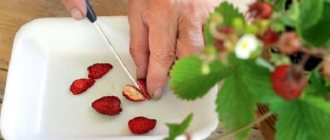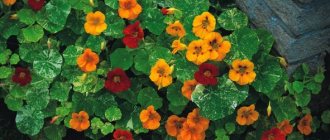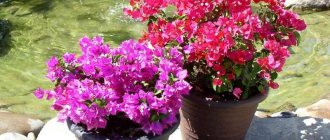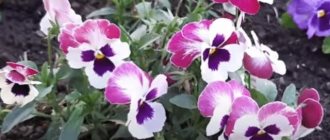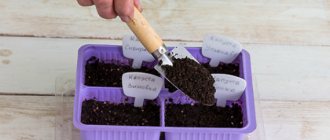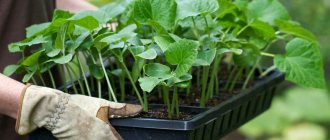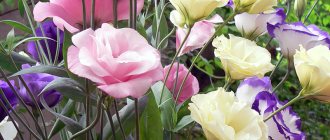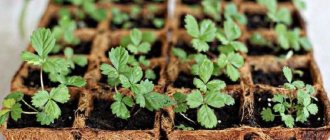Many gardeners like to plan their front garden or flower bed, that is, a combination of colors and sizes of flowers. Some experienced flower gardeners have concluded that carnations are perfect for any flower bed; they are a decoration for any flower arrangement.
But many questions arise about when to sow cloves for seedlings, when to plant them in open ground and how to care for them. You will find the answer to all these questions below, and so that you can definitely grow carnations, we share some tips and tricks.
Perennial carnation (lat. Dianthus) is widespread throughout the world. The botanical name of the herbaceous plant means divine flower
What varieties of cloves are grown from seeds?
Nature and breeders have developed about 300 varieties of cloves. Not all are suitable for growing from seeds. The most common varieties that are suitable for seed planting are:
- Dutch is a perennial, the main feature of which is considered to be long and abundant flowering, beginning in the second half of July and continuing until the onset of the first frost. Carnations bloom in different shades, but the most popular is red, edged with a white stripe.
- Chinese carnations can decorate any area in the garden or flower bed. The flowers are collected in inflorescences, the colors of which are very diverse and have a bluish tint.
- Pinnate is a small bush with double, densely packed flowers. This gives the variety a zest and unusualness.
- Turkish is an easy-to-care variety, the inflorescences of which on one bush can have different shades. Several inflorescences can form on one plant.
General information
The term "garden carnation" refers to a large group of plants belonging to the carnation family. Most are perennial flowering herbs native to the Mediterranean region. Some were bred artificially through hybridization. In our latitudes it is grown as an annual or biennial plant.
Garden carnations are bushy, branched, slender shrubs up to 60 cm high. The lower part can become woody with age, which makes the plant look like a subshrub. The leaves are entire, linear or linear-lanceolate, pointed at the apex, located opposite each other; green, sometimes covered with a bare green coating. The root system is superficial, poorly developed. Flowers can be single, up to 5-6 cm in diameter, or collected in umbrellas. The shape and color of the crown depend on the variety. Flowering is summer, some varieties last until October.
Photo of carnation flower
When to plant cloves for seedlings, in what month
To get strong and healthy seedlings, seeds begin to be sown at the end of February and finished in mid-April. Such a long sowing period is due to the fact that in this way it is possible to extend the flowering period of carnations in the flowerbed. Those bushes that are planted earlier will begin to bloom earlier, late plantings will bloom after them.
ATTENTION! You can sow seeds throughout the year, but it is better to do this from February to April.
Variety of species
In landscape design, garden carnations will look very harmonious both in group and individual compositions. Some varieties are even suitable for alpine flower beds and rockeries; they are planted along borders and dry streams. Garden carnations are often grown mixed into beds in the space vacated by early bulbous plants. These large-flowered species can form the basis of a flower arrangement, especially surrounded by greenery or against the backdrop of coniferous trees. This versatility is possible thanks to the large number of varieties.
Travyanka
Herbaceous perennial, common in Ukraine, Belarus and most of Russia; found even in Siberia and the Far East. In nature, it usually settles on sandy soils along rivers or on the edges of forests, and is found on roadsides. The shrub has a compact habit, about 25 cm high. The leaves are small, narrowly lanceolate, dark green. The flowers are small, with feathery petals of white, pinkish or purple. It blooms primarily in summer and may bloom again in early fall. Based on this species, there are many ground cover varieties with bright colors and different flowering periods.
Alpine carnation
This variety is easily recognized by its pubescent, soaring and wide plants up to 25 cm high. The leaves are small, narrow-lanceolate, glabrous, and green. The petals are jagged, jagged, and are usually pinkish, purple, or reddish in color. The first wave of flowering occurs in June-July, the second at the end of August. Under natural conditions, it most often settles in mountainous areas on limestone rocks. Found in the Alps and mountains of Slovenia, Italy and Austria. Used in gardening to decorate alpine rockeries, dry streams and rocky gardens.
Turkish cloves
Turkish carnation, also known as bearded carnation, is one of the most common species. It is undemanding to the soil and produces bright, abundant and long-lasting flowering with a strong aroma reminiscent of cloves. In nature, it most readily settles on rocky slopes at the edges of forests or along gravel-covered river beds.
This herbaceous perennial is easily identified by its bare, rounded stems and rough, lance-shaped leaves. Inflorescences are paniculate, up to 12 cm in diameter. The color is bright and contrasting, predominantly white, pinkish and reddish to dark burgundy. Petals are bicolored or tricolored, often with a border.
Turkish carnation blooms in the second year; grown as a biennial plant. Easily propagated from seeds. Every year many varieties appear, differing in the shape of the petals, pom-poms, color, size of the bush and inflorescences, and even aroma.
Knapp
Knappa is distinguished from other carnations by its bright yellow petals. This is a rare occurrence. Its inflorescences are similar in shape and smell to Turkish cloves. The shrub is compact, up to 35 cm tall; leaves and stems are gray-green. Knappa is grown as a biennial, blooming in the second year from July to August. Frost-resistant, but does not tolerate waterlogging very well. It is found in the wild only in Romania and Hungary.
Shabo
Garden carnation Shabot is one of the large-flowered varieties often grown for cut flowers. Flowers are solitary, up to 7 cm in diameter, flared or semi-flared; the petals are ruffled and deeply flared with pinkish, yellowish or reddish hues. Blooms from mid-summer until frost. Unlike most carnations, its root system is rhizomatous and strong. The stems can reach 60 cm in height. Leaves are opposite, linear, glabrous green, up to 12 cm long.
This species was bred artificially and is not found in the wild. It is grown everywhere, used not only in amateur gardening, but also in industrial gardening for landscaping parks and recreation areas. There are many varieties and hybrids, differing in the shape and color of the petals.
Dianthus pinnata
A neat, compact shrub up to 30 cm. The leaves are light green with well-defined longitudinal veins, which makes them look like feathers. The flowers are small, up to 3 cm, with a fringed, forked edge. The color spectrum is wide. The buds open en masse in late June - early July. In the wild, this flower prefers the calcareous soils of the European foothills.
Dutch carnation
Artificially bred species. It blooms profusely and for a long time from the beginning of summer until frost; in greenhouse conditions, flower buds bloom all year round. It has industrial value and is mass produced for cutting. The stems are dense, rounded, reaching 80 cm in height. The flowers are double or semi-double, often solitary. Many varieties have been bred with varied petal colors, white, reddish, pinkish, and cream colors predominate.
Chinese carnation
Chinese carnation, or, as it is also called, Amur carnation, grows mainly in Siberia, Primorye or the Far East on sandy or rocky slopes, or in meadows. It reaches a height of 40-45 cm. The stems are well branched; leaves lanceolate, pointed. Flowers up to 2.5 cm, can be pinkish, white, purple, violet or red.
It is a biennial plant, but blooms in the first year, from June to the end of August. Chinese carnation is a winter-hardy variety. He developed several popular hybrid series, the most famous of which is the Lilipot garden carnation. Its dwarf bushes can even be planted on windowsills. It comes in a variety of colors, including white, reddish, pinkish and carmine, and is usually sold as a seed mixture.
Planting a flower for seedlings depending on the region
Taking into account the timing of planting, it is important to take into account the characteristics of the growing regions. Each region has its own climatic characteristics that can affect the period and abundance of flowering.
In the southern regions, the climate is warm, which allows flower growers to receive seedlings earlier, and, therefore, the bushes will bloom faster.
The length of summer also affects the duration of flowering. In the southern regions, you can plant flowers for seedlings both in February and April.
The climate of the central regions is unpredictable and this can affect the carnation. There is no need to rush to sow here. It is better to start planting in March so that the carnation does not outgrow and form buds before it is planted in the soil. If this happens, the carnation takes a long time and has difficulty adapting, which does not have a very good effect on flowering.
But in the northern regions, where summer is late and short, it is better to sow in mid-March and not delay until April. Late shoots will not have time to form buds and will not bloom at all.
ATTENTION! When planting carnations, weather forecasters' forecasts should also be taken into account. In recent years, the climate in the regions has been changing, and the weather can bring unexpected surprises.
Plant diseases
It is extremely rare for carnations to get sick; this usually happens during heavy rainfall, as the soil becomes too wet.
Alternaria blight can affect carnations, causing black or brown spots to appear on the leaves and stems.
Another popular disease is rust, the name speaks for itself; red spots appear on the back of the leaves.
If you notice any disease, immediately remove the plant and water the planting site with a disinfecting solution.
Carnation rust
In case of viral diseases, the plant begins to slowly die; the cause of such diseases can be pests or untreated garden tools. In order to prevent the spread of the disease, it is necessary to get rid of the diseased plant.
In order to prevent the appearance of any plants, it is necessary to disinfect the seed, soil and container for planting. Also, treat plants against pests and remove weeds in a timely manner.
When to plant cloves for seedlings in 2022 according to the lunar calendar
As with planting all garden crops, it is recommended to plant carnations on favorable days, when the moon is in its waxing phase. It is this period that has a beneficial effect on growth, as well as the formation and strengthening of the root system.
Favorable days for planting carnations in 2022 according to the lunar calendar
Favorable days in 2022 for planting are:
| January | 3-17 |
| February | 2-15 |
| March | 3-17 |
| April | 2-15 |
| May | 1-15 |
| June | 1-13, 30 |
| July | 1-12, 29-31 |
| August | 1-11, 28-31 |
| September | 1-9, 27-30 |
| October | 1-8, 26-31 |
| november | 1-7, 25-30 |
| December | 1-7, 24-31 |
When is it not worth planting carnation seedlings in 2022 according to the lunar calendar?
The days when it is better to hold off on planting and do something else in 2022 are:
| January | 2, 18 |
| February | 1, 16 |
| March | 2, 18 |
| April | 1, 16, 30 |
| May | 16, 30 |
| June | 14, 29 |
| July | 13, 28 |
| August | 12, 27 |
| September | 10, 26 |
| October | 9, 25 |
| november | 8, 24 |
| December | 8, 23 |
What you need to plant carnation seedlings
Before planting seeds, you need to think through all the nuances of growing and prepare a substrate, a container for future seedlings and, most importantly, prepare the seeds for sowing.
How to choose the right variety of cloves?
To choose the right type of carnation, you need to decide exactly what you want to see on your site.
Varieties may differ from each other in the shape and color of buds and leaves, the height of the bush, and care requirements.
IMPORTANT! When choosing a variety, you must take into account the growing region and its climatic features.
How to choose seeds for planting
It is recommended to approach the selection of seeds for cultivation wisely and pay attention to the following criteria:
- date of manufacture - expired seeds will not give the desired result;
- the seeds must be ripe, this is easy to understand by their appearance;
- the seeds should not be too small;
- there should not be any raid on them.
What soil is needed for planting carnations?
Any universal soil is suitable for growing cloves, which can always be purchased at a specialty store.
Many gardeners prepare the substrate themselves. To do this, you will need humus, peat and garden soil in equal proportions. It is recommended to add a little sand or perlite to this mixture for looseness.
When preparing the soil substrate yourself, it is recommended to ensure that the acidity is neutral. To neutralize, you can add a small amount of ash to the substrate.
IMPORTANT! The substrate prepared independently must be disinfected. To do this, it can be soaked in a solution of phytosporin or potassium permanganate, frozen or doused with boiling water.
How to prepare seeds for sowing seedlings
Before sowing, the seeds are disinfected. To do this, you can use special immunomodulators or a solution of potassium permanganate.
Place a bag of seeds in a weak solution of manganese for 15-20 minutes, and then begin sowing. This procedure will prevent many diseases.
What not to do when planting cloves
Before sowing, you need to pay attention to the soil moisture; it should not be too high, and under no circumstances should you water the soil immediately before sowing.
Potassium chloride preparations and manure should not be used for feeding.
Pests and diseases
Carnation has a fairly strong immune system; it is difficult for diseases and pests to defeat it. The cause of disease can be infection; to prevent this, it is necessary to disinfect the soil, container and seeds.
Another common cause of disease is frequent watering.
Rust. With this disease, red spots appear; to cure the plant, you need to remove the affected leaves and treat the plant with a solution of Bordeaux mixture.
Mosaic disease. Black and white spots, which later cause holes to form. This disease cannot be treated; the plant just needs to be thrown out and the planting site treated.
Fusarium. This disease can be identified by a change in the color of the leaves from green to yellow, and blackening of the stem is also observed. This disease also cannot be treated; the plant simply needs to be disposed of.
Many plants can die due to attack by aphids, mites or any other insects; they can eat the above-ground part of the plant
Because of them, the carnation may lose its decorative effect; laundry soap helps fight pests; you can dilute a little soap with water and spray the plants with this solution.
Planting carnation seedlings at home, step-by-step photos
At home, growing carnation seedlings is available in two ways. Both methods are acceptable and do not require special preparation.
Growing indoors
The first method involves planting seeds early, which affects flowering time. To do this, seeds are sown evenly into a prepared container with a substrate, sprinkled with warm, settled water from a spray bottle and covered with glass until shoots appear. This method is suitable for all regions and is considered less risky.
Growing in open ground
This method is more suitable for warm southern regions, but even there there is a huge risk of getting a bad result.
With this method, immediately after establishing a positive air temperature, small furrows are made in the prepared area and clove seeds are sown. Before emergence, monitor the humidity. If necessary, cover the area with protective material from frost.
Description
This is a low growing spreading plant. The stems are divided into flowering and non-flowering, the first are taller and more branched, the second have more tall, narrow leaves. The five-petal flowers of this modification of the carnation are small; the color of the cultivated herb may depend on the species; it is diverse: all shades of scarlet, violet, azure, snow-white. At the base of each petal there is a dark line that follows the sinuous shape of the edge of the petal, this makes the flower very beautiful.
Wild watch of dark scarlet color. The flower is called “Clock” for its habit of joining its petals at sunset; in principle, it is also covered in the rain. Small seeds are in boxes and ripen in September. Carnation grass blooms all summer and is undemanding in care, in fact for this reason it is often used for decorating purposes.
Trending Pilaf with chicken and shrimp
In its natural environment it prefers sunny and dry places and loves suboceanic climates. Wild grass can be found in the European part of Russia in areas with a mild climate, in some regions of Siberia. It creates rich thickets that attract bees with its personal, delicate, sweet scent.
According to legend, Louis IX, who was later canonized, used herbal cloves to cure his Crusaders from the plague during the siege of the city of Tunis. This was during the last Crusade, in 1270. It is worth noting that the king himself died from the same disease.
How to care for carnation seedlings
Caring for seedlings is simple, and even inexperienced gardeners can handle it.
Caring for cloves immediately after sowing until seedlings emerge
Immediately after sowing, the soil is slightly moistened. The container is covered with glass or any transparent material, creating a greenhouse effect. The container is placed in a bright, warm place until shoots appear, while monitoring the humidity of the substrate.
ATTENTION! The container is ventilated daily, removing the glass for 15-20 minutes so that mold does not appear on the surface of the earth.
Caring for carnations after the entrances appear
After emergence, care consists of periodic watering and fertilizing. The soil is moistened using a spray bottle with filtered or settled water at room temperature. After germination, the glass is removed from the container and the container is placed on a bright window without direct sunlight.
How to care for carnation seedlings
Growing seedlings is not difficult, the main thing is to properly care for them and properly water and fertilize them.
Irrigation scheme
If you water the ground with a sprayer before the shoots appear, then after they appear, watering becomes even more careful. To prevent water droplets from falling on young plants and harming them, it is better to use a syringe.
There is no need to moisturize too much, as this will provoke fungal diseases.
Top dressing
Feeding is carried out at least once every 2-3 weeks. It is better to use complex fertilizers, where the content of all necessary microelements is balanced.
ATTENTION! When applying fertilizers, it is recommended to strictly follow the manufacturer's instructions.
Care instructions
Sunny, warm places.
Calcareous, well-drained soil, not too wet in winter.
Wild carnation species are unpretentious to soil composition and care, but need well-lit areas. Basically, they are used for planting in rock gardens, rockeries and as part of natural flower beds.
Cultivated varieties and hybrids are more capricious. They require fertile and well-drained soil and regular feeding. They are often grown as houseplants.
Watering
Moderate.
All species, except Dutch carnation, are drought-resistant. The Dutch variety is watered 2 times a week. The water is not cold, it is poured under the root. Excess moisture in the soil leads to the spread of fungal diseases.
Top dressing
Natural perennial species are fertilized in the spring, scattering humus over the thawed soil in a layer of 2-3 cm. In the second half of summer, it is useful to add ash for loosening, 2 cups per 1 sq. m.
m. Starting from the budding period, Dutch carnations are fed every 2 weeks with complex fertilizer for flowering annuals.
After flowering, it is advisable to feed it a second time - with a solution of complete mineral fertilizer.
Transfer
The flower tolerates transplantation well.
Seedlings are planted in the phase of 2-4 true leaves, without deepening the root collar. Perennial carnations - ground covers are planted once. at 4-5 years, as the curtains grow, simply separating the required part from the general mass.
Wintering
Perennial low-growing carnations tolerate winter well, covered with snow.
If there is not enough snow, the bushes are mulched with sawdust, straw, and covered with agro-fabric.
Video recommendations for carnation formation
From the channel Garden, vegetable garden, with your own hands.
Flower pick
Picking takes place in two stages. The first time they dive after the appearance of two normally developed leaves, the second time after four leaves have formed.
Picking is carried out according to the following scheme:
- the soil with young seedlings is watered abundantly;
- small drainage holes are made in the prepared containers, after which they are filled with substrate;
- small depressions are made in the ground for the root system of the seedling; they should be slightly larger than the roots;
- The sprout is moved to a new container and the substrate is slightly compacted.
After the plant adapts, you can use growth stimulants.
Planting carnations in open ground
On the site, seed sowing is planned immediately after positive air temperatures are established.
What varieties of carnations are suitable for planting in open ground?
Absolutely all varieties are suitable for this method of planting; you just need to take into account the characteristics of a particular variety and the climatic conditions of the region.
The most popular varieties are: Chinese carnation, pinnate, Turkish and Dutch.
When can you plant carnations in open ground?
Depending on the region, planting of cloves begins in mid-April. When sowing carnations directly into a flowerbed, you need to be prepared for the fact that some varieties will begin to bloom only in the second year.
How to plant in open ground, step by step?
Before planting, it is important to carefully prepare the area; there should be no debris or weeds on it.
- The area must be loosened and, if necessary, fertilizer and ash added to maintain the required acidity level.
- After this, shallow grooves are made, where the clove seeds are sown. It must be taken into account that the bushes will grow.
- The furrows are covered with a 1 cm layer of soil and moistened.
Preparing for winter
Perennial varieties of Turkish carnation are cold-resistant and tolerate winter cold well. But if there is no snow in winter or little snow falls, the bushes are covered with branches of coniferous trees or a layer of sawdust. This will protect the plant from freezing. In the spring, when the snow melts, the plants are temporarily shaded with agrofibre. This measure will protect the flower from sunburn.
If there is no snow, the beds are covered with spruce branches
Planting carnation seedlings in open ground
They begin to plant carnations in open ground in May, when night frosts have completely subsided. Despite the fact that cloves are a frost-resistant crop, frosts during this period can provoke long-term adaptation and, possibly, death.
How to choose a place to plant carnations
The area where it is planned to grow flowers should be well lit and protected from wind and drafts.
Where can you plant carnations?
Carnation goes well with many flower crops. They can be asters, delphinium, alpine plants, poppies and other decorative varieties.
How to prepare carnation seedlings for planting in open ground?
Before planting seedlings, they need to be prepared for this - hardened off.
They do this gradually. To begin with, the boxes are taken out into the fresh air for 5-10 minutes. Gradually, the time increases until the plant can be exposed to air even at night.
How to prepare a place to plant carnations outdoors
Before planting, the area is cleared of weeds and other debris. The soil is dug up and complex fertilizers are added there strictly in accordance with the recommendations on the packaging.
How to plant flowers correctly, step by step
Plants are planted according to the following scheme:
- depressions are made in the soil slightly larger than the root system of the flower; you can plant it with a lump of earth from an old container;
- the flower is planted in the prepared hole and covered with earth on top;
- The ground is compacted a little and slightly moistened with settled water at room temperature.

